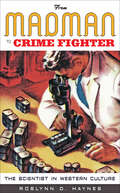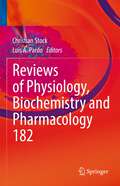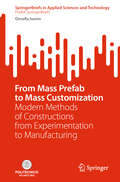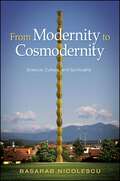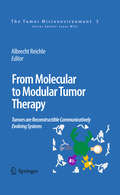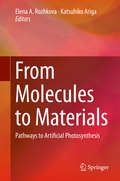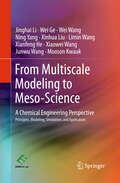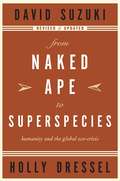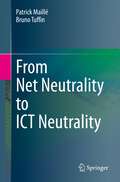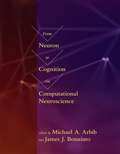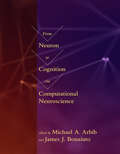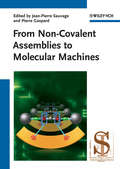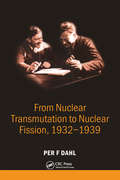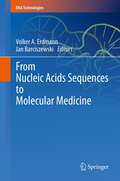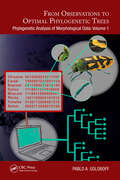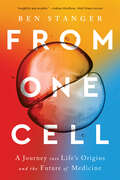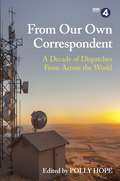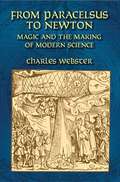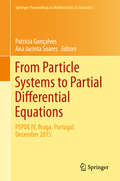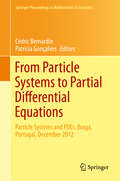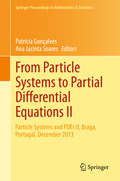- Table View
- List View
From Madman to Crime Fighter: The Scientist in Western Culture
by Roslynn D. HaynesThe story of the scientist in Western culture, from medieval images of alchemists to present-day depictions of cyberpunks and genetic engineers.They were mad, of course. Or evil. Or godless, amoral, arrogant, impersonal, and inhuman. At best, they were well intentioned but blind to the dangers of forces they barely controlled. They were Faust and Frankenstein, Jekyll and Moreau, Caligari and Strangelove—the scientists of film and fiction, cultural archetypes that reflected ancient fears of tampering with the unknown or unleashing the little-understood powers of nature.In From Madman to Crime Fighter, Roslynn D. Haynes analyzes stereotypical characters—including the mad scientist, the cold-blooded pursuer of knowledge, the intrepid pathbreaker, and the bumbling fool—that, from medieval times to the present day, have been used to depict the scientist in Western literature and film. She also describes more realistically drawn scientists, characters who are conscious of their public responsibility to expose dangers from pollution and climate change yet fearful of being accused of lacking evidence.Drawing on examples from Britain, America, Germany, France, Russia, and elsewhere, Haynes explores the persistent folklore of mad doctors of science and its relation to popular fears of a depersonalized, male-dominated, and socially irresponsible pursuit of knowledge for its own sake. She concludes that today’s public response to science and scientists—much of it negative—is best understood by recognizing the importance of such cultural archetypes and their significance as myth. From Madman to Crime Fighter is the most comprehensive study of the image of the scientist in Western literature and film.
From Madman to Crime Fighter: The Scientist in Western Culture
by Roslynn D. HaynesA study of the scientist in Western culture, from medieval images of alchemists to present-day depictions of cyberpunks and genetic engineers.They were mad, of course. Or evil. Or godless, amoral, arrogant, impersonal, and inhuman. At best, they were well intentioned but blind to the dangers of forces they barely controlled. They were Faust, Frankenstein, Jekyll, Moreau, Caligari, Strangelove—the scientists of film and fiction, cultural archetypes that reflected ancient fears of tampering with the unknown or unleashing the little-understood powers of nature.In From Madman to Crime Fighter, Roslynn D. Haynes analyzes stereotypical characters—including the mad scientist, the cold-blooded pursuer of knowledge, the intrepid pathbreaker, and the bumbling fool—that, from medieval times to the present day, have been used to depict the scientist in Western literature and film. She also describes more realistically drawn scientists, characters who are conscious of their public responsibility to expose dangers from pollution and climate change yet fearful of being accused of lacking evidence.Drawing on examples from Britain, America, Germany, France, Russia, and elsewhere, Haynes explores the persistent folklore of mad doctors of science and its relation to popular fears of a depersonalized, male-dominated, and socially irresponsible pursuit of knowledge for its own sake. She concludes that today’s public response to science and scientists—much of it negative—is best understood by recognizing the importance of such cultural archetypes and their significance as myth. From Madman to Crime Fighter is the most comprehensive study of the image of the scientist in Western literature and film.
From Malignant Transformation to Metastasis: Ion Transport in Tumor Biology (Reviews of Physiology, Biochemistry and Pharmacology #182)
by Christian Stock Luis A. PardoThis second book of the three-volume collection "Ion Transport in Tumor Biology" helps readers gain comprehensive knowledge of the pathophysiology of cancer. The authors highlight that ion transport proteins, channels and transporters - collectively referred to as the transportome - are significantly involved in the development and progression of cancer. Nearly 90% of malignant tumor diseases originate from epithelial cells, the function of which, for the most part, is based on the transportome. This volume focuses on molecular principles by showing that dysregulated expression and/or function of ion transporters have been correlated with malignancy in the vast majority of tumor diseases.Within the story of the various chapters, the authors line out various malfunctions of the transportome and where they can be found at different stages of the metastatic cascade. The authors describe how the interactions between the tumor cells' transportome and the environment reinforce mesenchymal behaviour of cancer cells and contribute to their uncontrolled proliferation, migration, invasion, intra- and extravasation up to the formation of metastases. As part of a three-volume collection, this book will fascinate members of the active research community, as well as clinicians from the cancer field.
From Mass Prefab to Mass Customization: Modern Methods of Constructions from Experimentation to Manufacturing (SpringerBriefs in Applied Sciences and Technology)
by Ornella IuorioThis book provides an overview of the latest innovations in prefabrication. It analyzes how digital, material, and process innovations are transforming the mass prefabrication of homes, schools, and offices into mass customization. It provides an understanding of available manufacturing processes, including distributed ownership of manufacturing, platform approaches, and robotics. It discusses how the integration of cutting-edge advanced construction techniques, coupled with robotic manufacturing and assembly from the earliest stages of building system design, has the potential to unlock new formal and technical paradigms. Investigating the impact of prefab in the context of climate emergency, the book analyzes the capacity and shortfall in delivering net zero emissions. It discusses the opportunities that Modern Methods of Construction provide to enable the transition towards circular constructions, from reuse to retrofitting. Including the users' experience, it demonstrates the importance of developing methodologies for capturing users' occupancy evaluation, as a means for understanding real performances, benchmarking indicators, and tuning systems to target the long-term well-being of the occupants. Referring to a plethora of emblematic cases, this work demonstrates the importance of investing in research and development to optimize construction systems, reduce material use, facilitate lean construction, advance mechanical and environmental performances, and move toward circular systems to close the loop. This book is aimed at practitioners, architects, technologists, researchers, and students in architectural engineering.
From Microstructure Investigations to Multiscale Modeling: Bridging the Gap
by Adnan Ibrahimbegovic Delphine Brancherie Pierre Feissel Salima BouvierMechanical behaviors of materials are highly influenced by their architectures and/or microstructures. Hence, progress in material science involves understanding and modeling the link between the microstructure and the material behavior at different scales. This book gathers contributions from eminent researchers in the field of computational and experimental material modeling. It presents advanced experimental techniques to acquire the microstructure features together with dedicated numerical and analytical tools to take into account the randomness of the micro-structure.
From Models to Simulations (History and Philosophy of Technoscience)
by Franck VarenneThis book analyses the impact computerization has had on contemporary science and explains the origins, technical nature and epistemological consequences of the current decisive interplay between technology and science: an intertwining of formalism, computation, data acquisition, data and visualization and how these factors have led to the spread of simulation models since the 1950s. Using historical, comparative and interpretative case studies from a range of disciplines, with a particular emphasis on the case of plant studies, the author shows how and why computers, data treatment devices and programming languages have occasioned a gradual but irresistible and massive shift from mathematical models to computer simulations.
From Modernity to Cosmodernity: Science, Culture, and Spirituality (SUNY series in Western Esoteric Traditions)
by Basarab NicolescuThe quantum, biological, and information revolutions of the twentieth and twenty-first centuries should have thoroughly changed our view of reality, yet the old viewpoint based on classical science remains dominant, reinforcing a notion of a rational, mechanistic world that allows for endless progress. In practice, this view has promoted much violence among humans. Basarab Nicolescu heralds a new era, cosmodernity, founded on a contemporary vision of the interaction between science, culture, spirituality, religion, and society. Here, reality is plastic and its people are active participants in the cosmos, and the world is simultaneously knowable and unknowable. Ultimately, every human recognizes his or her face in the face of every other human being, independent of his or her particular religious or philosophical beliefs. Nicolescu notes a new spirituality free of dogmas and looks at quantum physics, literature, theater, and art to reveal the emergence of a newer, cosmodern consciousness.
From Molecular to Modular Tumor Therapy:
by Albrecht ReichleThe traditional problem of the poor presentability as well as diagnostic and therapeutic practicability of individual patient care is still unresolved. The present book aims at leading the reader (cancer researchers, pharmacologists, biologists) away-in a scientifically accessible manner-from the daily conflicts between theory and practice and between the generalized and individual tumor patient, so that more personalized diagnostic and therapeutic strategies can be developed for controlling metastatic tumor disease: * First, recording the systems concept of tumor biology based on rather different sciences (biochemistry, cell biology, and medical oncology) including their potential contribution to communication, * then, giving reductionistically derived systems features an internal communicative context (formal-pragmatic communication theory), and * finally, binding the systems features to (tumor-immanent) evolutionary processes (modularity of biochemical and cellular processes,rat.
From Molecules to Materials
by Katsuhiko Ariga Elena A. RozhkovaThis interdisciplinary book focuses on the various aspects transformation of the energy from sunlight into the chemical bonds of a fuel, known as the artificial photosynthesis, and addresses the emergent challenges connected with growing societal demands for clean and sustainable energy technologies. The editors assemble the research of world-recognized experts in the field of both molecular and materials artificial systems for energy production. Contributors cover the full scope of research on photosynthesis and related energy processes.
From Multiscale Modeling to Meso-Science
by Wei Wang Limin Wang Jinghai Li Junwu Wang Mooson Kwauk Ning Yang Wei Ge Xianfeng He Xiaowei Wang Xinhua LiuMultiscale modeling is becoming essential for accurate, rapid simulation in science and engineering. This book presents the results of three decades of research on multiscale modeling in process engineering from principles to application, and its generalization for different fields. This book considers the universality of meso-scale phenomena for the first time, and provides insight into the emerging discipline that unifies them, meso-science, as well as new perspectives for virtual process engineering. Multiscale modeling is applied in areas including: multiphase flow and fluid dynamicschemical, biochemical and process engineeringmineral processing and metallurgical engineeringenergy and resourcesmaterials science and engineeringJinghai Li is Vice-President of the Chinese Academy of Sciences (CAS), a professor at the Institute of Process Engineering, CAS, and leader of the EMMS (Energy-minimizing multiscale) Group. Wei Ge, Wei Wang, Ning Yang and Junwu Wang are professors at the EMMS Group, part of the Institute of Process Engineering, CAS. Xinhua Liu, Limin Wang, Xianfeng He and Xiaowei Wang are associate professors at the EMMS Group, part of the Institute of Process Engineering, CAS. Mooson Kwauk is an emeritus director of the Institute of Process Engineering, CAS, and is an advisor to the EMMS Group.
From Naked Ape to Superspecies
by David Suzuki Holly DresselFor millennia, we lived in harmony with the Earth, taking only what we required to survive. But in just the past few centuries, we have used our powers to satisfy our obsession with consumption and new technology, without regard for the consequences. And in doing so, we have exploited our surroundings on an unprecedented scale. In this revised and updated edition of From Naked Ape to Superspecies, David Suzuki and Holly Dressel lucidly describe how we have evolved beyond our needs, trampling other species, believing that we can make the Earth work the way we want it to. And they introduce us to the people who are fighting back, those who are resisting the inexorable advance of the "global economy" juggernaut, the people whose voices are difficult to hear over the din of corporate public relations machines. We learn about how human arrogance-demonstrated by our disregard for the small and microscopic species that constitute the Earth's engine and our reckless use of technological inventions like powerful herbicides or genetically engineered crops-is threatening the health of our children and the safety of our food supply.
From Net Neutrality to ICT Neutrality
by Patrick Maillé Bruno TuffinThis book discusses the pros and cons of information and communication (ICT) neutrality. It tries to be as objective as possible from arguments of proponents and opponents, this way enabling readers to build their own opinion. It presents the history of the ongoing network neutrality debate, the various concepts it encompasses, and also some mathematical developments illustrating optimal strategies and potential counter-intuitive results, then extends the discussion to connected ICT domains. The book thus touches issues related to history, economics, law, networking, and mathematics. After an introductory chapter on the history of the topic, chapter 2 surveys and compares the various laws in place worldwide and discusses some implications of heterogeneous rules in several regions. Next, chapter 3 details the arguments put forward by the participants of the net neutrality debate. Chapter 4 then presents how the impact of neutral or non-neutral behaviors can be analyzed mathematically, with sometimes counter-intuitive results, and emphasizes the interest of modeling to avoid bad decisions. Chapter 5 illustrates that content providers may not always be on the pro-neutrality side, as there are situations where they may have an economic advantage with a non-neutral situation, e.g. when they are leaders on a market and create barriers to entry for competitors. Another related issue is covered in chapter 6, which discusses existing ways for ISPs to circumvent the packet-based rules and behave non-neutral without breaking the written law. Chapter 7 gives more insight on the role and possible non-neutral behavior of search engines, leading to another debate called the search neutrality debate. Chapter 8 focuses on e-commerce platforms and social networks, and investigates how they can influence users’ actions and opinions. The issue is linked to the debate on the transparency of algorithms which is active in Europe especially. Chapter 9 focuses on enforcing neutrality in practice through measurements: indeed, setting rules requires monitoring the activity of ICT actors in order to sanction non-appropriate behaviors and be proactive against new conducts. The chapter explains why this is challenging and what tools are currently available. Eventually, Chapter 10 briefly concludes the presentation and opens the debate.
From Neuron to Brain
by John Nicholls Antonino Cattaneo A. Robert Martin David A. Brown Mathew E. Diamond Francisco F. De-MiguelFrom Neuron to Brain, Sixth Edition, provides a readable, up-to-date book for use in undergraduate, graduate, and medical school courses in neuroscience. As in previous editions, the emphasis is on experiments made by electrical recordings, molecular and cellular biological techniques, and behavioral studies on the nervous system, from simple reflexes to cognitive functions. Lines of research are followed from the inception of an idea to new findings being made in laboratories and clinics today. <p><p>From Neuron to Brain will be of interest to anyone--with or without a specialized background in biological sciences--who is curious about the workings of the nervous system.
From Neuron to Cognition via Computational Neuroscience
by Michael A. Arbib James J. BonaiutoThis textbook presents a wide range of subjects in neuroscience from a computational perspective. It offers a comprehensive, integrated introduction to core topics, using computational tools to trace a path from neurons and circuits to behavior and cognition. Moreover, the chapters show how computational neuroscience -- methods for modeling the causal interactions underlying neural systems -- complements empirical research in advancing the understanding of brain and behavior. The chapters -- all by leaders in the field, and carefully integrated by the editors -- cover such subjects as action and motor control; neuroplasticity, neuromodulation, and reinforcement learning; vision; and language -- the core of human cognition.The book can be used for advanced undergraduate or graduate level courses. It presents all necessary background in neuroscience beyond basic facts about neurons and synapses and general ideas about the structure and function of the human brain. Students should be familiar with differential equations and probability theory, and be able to pick up the basics of programming in MATLAB and/or Python. Slides, exercises, and other ancillary materials are freely available online, and many of the models described in the chapters are documented in the brain operation database, BODB (which is also described in a book chapter).ContributorsMichael A. Arbib, Joseph Ayers, James Bednar, Andrej Bicanski, James J. Bonaiuto, Nicolas Brunel, Jean-Marie Cabelguen, Carmen Canavier, Angelo Cangelosi, Richard P. Cooper, Carlos R. Cortes, Nathaniel Daw, Paul Dean, Peter Ford Dominey, Pierre Enel, Jean-Marc Fellous, Stefano Fusi, Wulfram Gerstner, Frank Grasso, Jacqueline A. Griego, Ziad M. Hafed, Michael E. Hasselmo, Auke Ijspeert, Stephanie Jones, Daniel Kersten, Jeremie Knuesel, Owen Lewis, William W. Lytton, Tomaso Poggio, John Porrill, Tony J. Prescott, John Rinzel, Edmund Rolls, Jonathan Rubin, Nicolas Schweighofer, Mohamed A. Sherif, Malle A. Tagamets, Paul F. M. J. Verschure, Nathan Vierling-Claasen, Xiao-Jing Wang, Christopher Williams, Ransom Winder, Alan L. Yuille
From Neuron to Cognition via Computational Neuroscience (Computational Neuroscience Series)
by Michael A. Arbib James J. BonaiutoA comprehensive, integrated, and accessible textbook presenting core neuroscientific topics from a computational perspective, tracing a path from cells and circuits to behavior and cognition.This textbook presents a wide range of subjects in neuroscience from a computational perspective. It offers a comprehensive, integrated introduction to core topics, using computational tools to trace a path from neurons and circuits to behavior and cognition. Moreover, the chapters show how computational neuroscience—methods for modeling the causal interactions underlying neural systems—complements empirical research in advancing the understanding of brain and behavior. The chapters—all by leaders in the field, and carefully integrated by the editors—cover such subjects as action and motor control; neuroplasticity, neuromodulation, and reinforcement learning; vision; and language—the core of human cognition.The book can be used for advanced undergraduate or graduate level courses. It presents all necessary background in neuroscience beyond basic facts about neurons and synapses and general ideas about the structure and function of the human brain. Students should be familiar with differential equations and probability theory, and be able to pick up the basics of programming in MATLAB and/or Python. Slides, exercises, and other ancillary materials are freely available online, and many of the models described in the chapters are documented in the brain operation database, BODB (which is also described in a book chapter).ContributorsMichael A. Arbib, Joseph Ayers, James Bednar, Andrej Bicanski, James J. Bonaiuto, Nicolas Brunel, Jean-Marie Cabelguen, Carmen Canavier, Angelo Cangelosi, Richard P. Cooper, Carlos R. Cortes, Nathaniel Daw, Paul Dean, Peter Ford Dominey, Pierre Enel, Jean-Marc Fellous, Stefano Fusi, Wulfram Gerstner, Frank Grasso, Jacqueline A. Griego, Ziad M. Hafed, Michael E. Hasselmo, Auke Ijspeert, Stephanie Jones, Daniel Kersten, Jeremie Knuesel, Owen Lewis, William W. Lytton, Tomaso Poggio, John Porrill, Tony J. Prescott, John Rinzel, Edmund Rolls, Jonathan Rubin, Nicolas Schweighofer, Mohamed A. Sherif, Malle A. Tagamets, Paul F. M. J. Verschure, Nathan Vierling-Claasen, Xiao-Jing Wang, Christopher Williams, Ransom Winder, Alan L. Yuille
From Non-Covalent Assemblies to Molecular Machines
by Pierre Gaspard Jean-Pierre SauvageBased on the Solvay conference, which gathers the leading scientists in the field, this monograph collects review articles from the six topics of the conference, while also including comments, discussions and debates obtained during the conference. The issues discussed at this landmark conference were: * Noncovalent Assemblies: Design and Synthesis * Template Synthesis of Catenanes and Rotaxanes * Molecular Machines Based on Catenanes and Rotaxanes * Molecular Machines Based on Non-Interlocking Molecules * Towards Molecular Logics and Artificial Photosynthesis * From Single Molecules to Practical Devices and the authors add their personal views on the future of each of their own research areas. Novel reading for organic, inorganic and polymer chemists, as well as materials scientists.
From Nuclear Transmutation to Nuclear Fission, 1932-1939
by Per F. DahlFrom Nuclear Transmutation to Nuclear Fission, 1932-1939 deals with a particular phase in the early history of nuclear physics: the race among four laboratory teams to be the first to achieve the transmutation of atomic nuclei with artificially accelerated nuclear projectiles (protons) in high-voltage discharge tubes. This volume covers the backgro
From Nucleic Acids Sequences to Molecular Medicine
by Jan Barciszewski Volker A. ErdmannDespite a half century of structural, biophysical and biochemical investigations of ribonucleic acids, they are still mysterious. RNAs stand at fertile crossroads of disciplines, integrating concepts from genomics, proteomics, dynamics as well as biochemistry and molecular biology. From 20 years it is clear, that genetic regulation of eukaryotic organisms has been misunderstood for the last years that the expression of genetic information is effected only by proteins. Basic understanding of nucleic acids has enhanced our foundation to probe novel biological functions. This is especially evident for RNA molecules whose functionality, maturation, and regulation require formation of correct secondary structure through encoded base-pairing interactions.
From Observations to Optimal Phylogenetic Trees: Phylogenetic Analysis of Morphological Data: Volume 1 (Species and Systematics)
by Pablo A. GoloboffTaxonomists specializing in different groups once based phylogenetic analysis only on morphological data; molecular data was used more rarely. Although molecular systematics is routine today, the use of morphological data continues to be important, especially for phylogenetic placement of many taxa known only from fossils and rare or difficult to collect species. In addition, morphological analyses help identify potential biases in molecular analyses. And finally, scenarios with respect to morphology continue to motivate biologists: the beauty of a cheetah or a baobab does not lie in their DNA sequence, but instead on what they are and do! This book is an up-to-date revision of methods and principles of phylogenetic analysis of morphological data. It is also a general guide for using the computer program TNT in the analysis of such data. The book covers the main aspects of phylogenetic analysis and general methods to compare classifications derived from molecules and morphology. The basic aspects of molecular analysis are covered only as needed to highlight the differences with methods and assumptions for analysis of morphological datasets.
From One Cell: A Journey Into Life's Origins And The Future Of Medicine
by Ben Stanger“Insightful and erudite.”—Adrian Woolfson, Wall Street Journal Inside the quest to unlock the mysteries of development—and find the key to transforming our future. Each of us began life as a single cell. From this humble origin, we embarked on a risky journey fraught with opportunities for disaster. Yet, amazingly, we reached our destination intact, emerging as dazzlingly complex, exquisitely engineered assemblages of trillions of cells. This metamorphosis constitutes one of nature’s most spectacular yet commonplace magic tricks—and one of its most coveted secrets. In From One Cell, physician and researcher Ben Stanger offers a breathtaking glimpse into what scientists are discovering about how life and the body take shape, and how these revelations stand to revolutionize medicine and the future of human health. In vivid prose, Stanger leads readers on a gripping odyssey retracing this universal, yet unremembered, rite of passage. Through the eyes of the scientists unraveling development’s riddles in experiments as painstaking as they are inventive, we confront fascinating puzzles: how does the plethora of different tissues that compose our bodies arise from a single source? How do cells know what they are meant to become—skin or bone, blood or muscle—when all carry the same set of genetic instructions? Once a cell starts developing down one path, can it change its mind, or is its destiny irrevocably sealed? As Stanger shows us, the answers to these questions may at last empower us to solve some of our most persistently confounding medical challenges, from cancer to cognitive decline to degenerative disease. Recognizing tumors as evil doppelgangers of the embryo points the way toward new, more targeted cancer therapies. Learning how cells choose their identities and find their way in space could unlock lifesaving breakthroughs in regenerative medicine. The possibilities are extraordinary. Popular science at its best, From One Cell celebrates the power and beauty of understanding our collective beginnings.
From Our Own Correspondent: Dispatches of a Decade from Across the World
by Polly Hope<p>For more than sixty-five years on the air, From Our Own Correspondent has been one of BBC Radio's flagship programmes. It has taken listeners to parts of the world where they have never gone, and perhaps never would: war zones, refugee camps, elite universities, space stations, spy academies and lions' dens of all sorts. Its dispatches introduce audiences to people they might never expect to meet - kingpins, revolutionaries, assassins and outcasts. It has always relied on the power of personal testimony, with its contributors not merely reporting the news, but sharing what they found out along the way, and how it felt. Its correspondents often relate the unexpected: the day they visited the town that is crazy about trout fishing, attended a forty-course Chinese banquet, experienced zero gravity on a flight with Russian cosmonauts, went mud wrestling in Turkey or ballroom dancing in Cameroon.<p> <p>Themed by continent and region, From Our Own Correspondent brings together the most compelling stories of the past ten years. It is a perfect primer for the understanding of the modern world.<p>
From Paracelsus to Newton: Magic and the Making of Modern Science
by Charles WebsterThe alchemist and physician known as Paracelsus (1493-1541) appears to have dwelt in a completely different intellectual world from Sir Isaac Newton (1642-1727). Newton's work lies in the lofty era of the Enlightenment and the modern world, while that of the enigmatic Paracelsus conjures up the superstitious lore of the Dark Ages. The rise of science and the decline of magic unfolded over many generations, and as this fascinating book shows, there existed remarkable elements of continuity between the world views of the early sixteenth and late seventeenth centuries.The essays contained in this volume constitute a slightly modified version of the Eddington Lectures, delivered at Cambridge in the autumn of 1980. In this masterly series of discourses, Charles Webster explores three test cases relating to prophecy, spiritual magic, and demonic magic. Focusing on evidence from Germany at the time of the Reformation and from England during the Restoration, these essays form a more balanced historical perspective on the epistemological shift that occurred between the ages of Paracelsus and Newton. They propose a view of the Scientific Revolution as a diverse phenomenon, the result of a dynamic interplay of forces emanating from many different directions, and all contributing to the process of creativity and change. 20 black-and-white illustrations. Introduction. Notes to each chapter.
From Particle Systems to Partial Differential Equations
by Patrícia Gonçalves Ana Jacinta SoaresThis book focuses on mathematical problems concerning different applications in physics, engineering, chemistry and biology. It covers topics ranging from interacting particle systems to partial differential equations (PDEs), statistical mechanics and dynamical systems. The purpose of the second meeting on Particle Systems and PDEs was to bring together renowned researchers working actively in the respective fields, to discuss their topics of expertise and to present recent scientific results in both areas. Further, the meeting was intended to present the subject of interacting particle systems, its roots in and impacts on the field of physics and its relation with PDEs to a vast and varied public, including young researchers. The book also includes the notes from two mini-courses presented at the conference, allowing readers who are less familiar with these areas of mathematics to more easily approach them. The contributions will be of interest to mathematicians, theoretical physicists and other researchers interested in interacting particle systems, partial differential equations, statistical mechanics, stochastic processes, kinetic theory, dynamical systems and mathematical modeling aspects.
From Particle Systems to Partial Differential Equations
by Patricia Gonçalves Cédric BernardinThis book presents the proceedings of the international conference Particle Systems and Partial Differential Equations I, which took place at the Centre of Mathematics of the University of Minho, Braga, Portugal, from the 5th to the 7th of December, 2012. The purpose of the conference was to bring together world leaders to discuss their topics of expertise and to present some of their latest research developments in those fields. Among the participants were researchers in probability, partial differential equations and kinetics theory. The aim of the meeting was to present to a varied public the subject of interacting particle systems, its motivation from the viewpoint of physics and its relation with partial differential equations or kinetics theory and to stimulate discussions and possibly new collaborations among researchers with different backgrounds. The book contains lecture notes written by François Golse on the derivation of hydrodynamic equations (compressible and incompressible Euler and Navier-Stokes) from the Boltzmann equation, and several short papers written by some of the participants in the conference. Among the topics covered by the short papers are hydrodynamic limits; fluctuations; phase transitions; motions of shocks and anti shocks in exclusion processes; large number asymptotics for systems with self-consistent coupling; quasi-variational inequalities; unique continuation properties for PDEs and others. The book will benefit probabilists, analysts and mathematicians who are interested in statistical physics, stochastic processes, partial differential equations and kinetics theory, along with physicists.
From Particle Systems to Partial Differential Equations II
by Patrícia Gonçalves Ana Jacinta SoaresThis book focuses on mathematical problems concerning different applications in physics, engineering, chemistry and biology. It covers topics ranging from interacting particle systems to partial differential equations (PDEs), statistical mechanics and dynamical systems. The purpose of the second meeting on Particle Systems and PDEs was to bring together renowned researchers working actively in the respective fields, to discuss their topics of expertise and to present recent scientific results in both areas. Further, the meeting was intended to present the subject of interacting particle systems, its roots in and impacts on the field of physics and its relation with PDEs to a vast and varied public, including young researchers. The book also includes the notes from two mini-courses presented at the conference, allowing readers who are less familiar with these areas of mathematics to more easily approach them. The contributions will be of interest to mathematicians, theoretical physicists and other researchers interested in interacting particle systems, partial differential equations, statistical mechanics, stochastic processes, kinetic theory, dynamical systems and mathematical modeling aspects.
